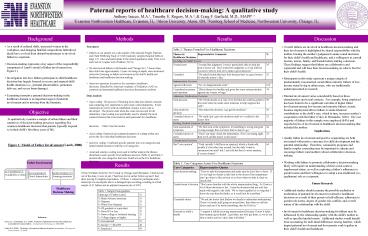Paternal reports of healthcare decisionmaking: A qualitative study - PowerPoint PPT Presentation
1 / 1
Title:
Paternal reports of healthcare decisionmaking: A qualitative study
Description:
Paternal reports of healthcare decision-making: A qualitative study ... 1Evanston Northwestern Healthcare, Evanston, IL; 2Akron University, Akron, OH, ... – PowerPoint PPT presentation
Number of Views:36
Avg rating:3.0/5.0
Title: Paternal reports of healthcare decisionmaking: A qualitative study
1
Paternal reports of healthcare decision-making A
qualitative study Anthony Isacco, M.A.¹, Timothy
E. Rogers, M.A.², Craig F. Garfield, M.D.,
MAPP¹ ³
1Evanston Northwestern Healthcare, Evanston, IL
2Akron University, Akron, OH, ³Feinberg School of
Medicine, Northwestern University, Chicago, IL
Methods
Background
Discussion
Results
- As a result of cultural shifts, increased women
in the workplace, and changing familial
compositions fatherhood ideals have evolved from
distant breadwinners to involved fathers to
coparents. - Decision-making represents a key aspect of the
responsibility component of Lambs model of
father involvement (see Figure 1). - Investigation into how fathers participate in
child healthcare decisions has largely focused on
severe and atypical child health situations
(i.e., prenatal abnormalities, premature
delivery, and severe brain damage). - Examining normative paternal decision-making in
the healthcare domain is an important aspect of
paternal involvement and is missing from the
literature.
- Procedures
- Fathers in our sample are a sub-sample of the
national Fragile Families and Child Wellbeing
Study of 3,600 randomly sampled hospital births
in large U.S. cities and participants in the
nested qualitative study Time Love and Cash in
Couples with Children (TLC3). - We interviewed fathers in Milwaukee and Chicago
for 1.5 hours when their child was approximately
3 years old using in-depth, semi-structured
interviews focusing on father involvement in the
childs health and healthcare and healthcare
decision-making. - Interview questions focused on five normative
healthcare decisions, identified by American
Academy of Pediatrics (AAP) as common and
important healthcare decisions that parents
confront. - Data Analysis
- Open coding The process of breaking down data
into distinct concepts and comparing new
statements to previously coded statements. If
new statements do not fit with an established
concept, a new code is developed. The process
ends when the codes can account for all
statements. Open coding was specifically used to
identify the most common themes that were found
in each particular five healthcare decisions.
Table 2 has the results. - Axial coding Explored and compared patterns of
coding within and across the five individual
healthcare decisions. - Selective coding Combined specific patterns into
core categories and linked related narratives
with the core categories. - Axial and selective coding were used to further
analyze the themes identified in each specific
five healthcare decision (Table 2) and Table 3
presents the core categories that were found
across the five healthcare decisions.
- Overall, fathers are involved in healthcare
decision-making and their involvement is
highlighted by shared responsibility with the
mother, trusting the mothers judgment to make
sound decisions for their childs health and
healthcare, and a willingness to consult doctors,
nurses, family, and friends before making a
decision. These findings suggest that fathers
are collaborative and coparental and will base
their decision-making on what is best for their
childs health. - Participants in this study represent a unique
sample of predominately non-married,
racial/ethnic minority fathers of low-income
status living in urban areas, who are
traditionally underrepresented in research. - Paternal involvement varies considerably based on
those characteristics and social contexts. For
example, being employed has been found to be a
significant correlate of higher father
involvement among low-income and minority
fathers, in part, because employment allows
fathers to make financial contributions to the
childs care, which in turn, increases mothers
cooperation with the father (Coley Hernandez,
2006). The vast majority of fathers in this
sample were employed (84) and reported styles of
involvement in healthcare decision-making that
included the mother. - Implications
- Quality father involvement and positive
coparenting are both associated with positive
outcomes for child development and the parental
relationship. Therefore, community programs and
family/couples counseling may be important to
educate and encourage fathers (and mothers) about
collaborative decision-making. - Working with fathers to promote collaborative
decision-making likely will require an
understanding of their social context, employment
status, as well as exploring a fathers adherence
to gender norms and their willingness to adopt a
non-traditional (i.e., egalitarian) role as a
coparent. - Future Research
- Additional studies should examine the possible
mediation or moderation of paternal involvement
in normative healthcare decisions as a result of
their perceived self-efficacy, adherence to
gender role norms, degree of gender role
conflict, and overall nature of the relationship
with the child. - Involvement in healthcare decision-making for
fathers may be influenced by the relationship
quality with the childs mother as well as
specific familial norms. Additional studies
would benefit from accounting for individual
differences among families, which impact paternal
involvement and how parents work together in
their childs health and healthcare.
Objective
To qualitatively examine a sample of urban
fathers and their narratives of decision-making
processes regarding five common healthcare
decisions that parents typically respond to in
their childs first three years of life.
.
Figure 1 Model of Father Involvement (Lamb, 2000)
Results
Of the 50 fathers from the TLC3 study in Chicago
and Milwaukee, 3 had moved out of the state, 6
were in jail, 7 had been lost in earlier
follow-up and 1 had died, leaving 33 eligible
respondents. Of those, 1 refused to participate
and 1 transcript was incomplete due to a damaged
tape recording, resulting in a final sample of 31
fathers and an adjusted response rate of 94.
Healthcare Decision-Making
References Coley, R.L. Hernandez, D.C. (2006).
Predictors of paternal involvement for resident
and nonresident low-income fathers.
Developmental Psychology, 42, 1041-1056. Lamb,
M.E. (2000). The history of research on father
involvement An overview. Marriage and Family
Review, 29, 23-42.































